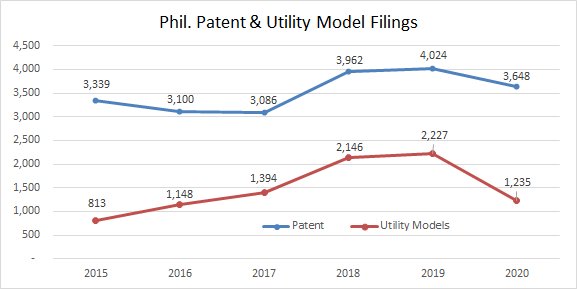MONDAY MACRO: Creating long-term economic growth might be more difficult if this chart’s trend continues

Many news headlines have talked about the pandemic’s impact on GDP, unemployment, inflation, and other figures. While these are important to monitor, one other indicator might be slipping under the radar, even though it seems as significant as the rest.
Technological progress is key for an economy to sustain long-term growth and this indicator might be showing a decline in Philippine innovation.
Philippine Markets Daily:
The Monday Macro Report
Powered by Valens Research
The Philippine Statistics Authority (PSA) recently revised its 2020 Gross Domestic Product (GDP) estimates, after receiving more preliminary data. The results are worse than expected, with the PSA estimating the Philippines’ GDP to have shrunk 9.6% in 2020 compared to 2019.
In one of our Monday articles last June, we talked about how research and financial institutions were only forecasting a 4% GDP shrinkage at the time. Some even thought that GDP growth was still possible in 2020 if the country could realize its growth catalysts.
In light of the new numbers, international think tanks are now downgrading the Philippines’ rebound in 2021. For example, the World Bank has recently slashed its 2021 GDP forecast for the country from 5.9% to 5.5%.
The community quarantines due to COVID-19 have hindered economic activities for much of the year. Even to this day, the Philippines still remains under quarantine as the number of new cases each day remains above 10,000 on average.
As a result, the performance of the country’s long-term growth drivers has been concerning. High unemployment persists while foreign direct investments (FDIs) are still on a decline.
More importantly, the ability of Filipinos to innovate continues to be hindered by the pandemic.
Textbook economic theory tells us that an economy’s long-term growth rate is modeled based on population growth and capital investment. However, as labor and capital reach full capacity, productivity improvements are ultimately needed to generate sustainable long-term growth.
Productivity improvements mainly come in the form of technological progress or innovation. Because of innovation, people find new and more efficient ways to utilize the same resources and capital.
Innovations are difficult to create, which is why it is important to foster an environment where a lot of it can take place, successful or not. To do so, we must first be able to measure innovation, which is another difficult task because of its intangibility.
An imperfect, but reasonable alternative to measuring innovation is the number of patent and utility model applications being filed annually in a country. Utility models are like patents, but less stringent and with shorter periods.
The Intellectual Property Office of the Philippines (IPOPHL) is in charge of the country’s intellectual property system. Based on their data, patent filings (blue line) had been rising from 2017-2019 while utility model filings (red line) nearly tripled from 2015-2019.

However in 2020, patent filings dropped by 9% and utility model filings fell by nearly half, attributable to the long Enhanced Community Quarantine (ECQ) according to the IPOPHL’s director general.
This is troubling as it could signal the Philippines’ reduced ability to generate long-term growth if the current trend persists.
Taking a look at the publicly traded Philippine companies specifically, innovation can be measured based on R&D costs. The chart below shows the Uniform ROAs (blue bars) of the 30 companies that have historically spent on R&D (orange line).

Compared to the aggregate performance of the entire PSE, ‘innovating’ companies tend to have more volatile performance. Over the past decade, Uniform ROAs have fallen to levels as low as 5%, but have also risen as high as 8%.
The volatility can be partially explained by the timing differences caused by R&D. Successful innovations often take a long time before it starts contributing to earnings. Meanwhile, under the Uniform Accounting framework, R&D costs are capitalized and are immediately added to the firm’s asset base.
As such, periods of high R&D spending growth in the years 2008, 2012, and 2018 lead to a sudden compression in Uniform ROAs. However, over time, Uniform ROAs do recover and even expand to new historical highs.
We’ve yet to see the release of the complete 2020 data, but if R&D spending mirrors the current patent and utility model trends, then the long-term growth prospects of these ‘innovating’ companies will likely face higher risk.
About the Philippine Market Daily
“The Monday Macro Report”
When just about anyone can post just about anything online, it gets increasingly difficult for an individual investor to sift through the plethora of information available.
Investors need a tool that will help them cut through any biased or misleading information and dive straight into reliable and useful data.
Every Monday, we publish an interesting chart on the Philippine economy and stock market. We highlight data that investors would normally look at, but through the lens of Uniform Accounting, a powerful tool that gets investors closer to understanding the economic reality of firms.
Understanding what kind of market we are in, what leading indicators we should be looking at, and what market expectations are, will make investing a less monumental task than finding a needle in a haystack.
Hope you’ve found this week’s macro chart interesting and insightful.
Stay tuned for next week’s Monday Macro report!
Regards,
Angelica Lim
Research Director
Philippine Markets Daily
Powered by Valens Research
www.valens-research.com




